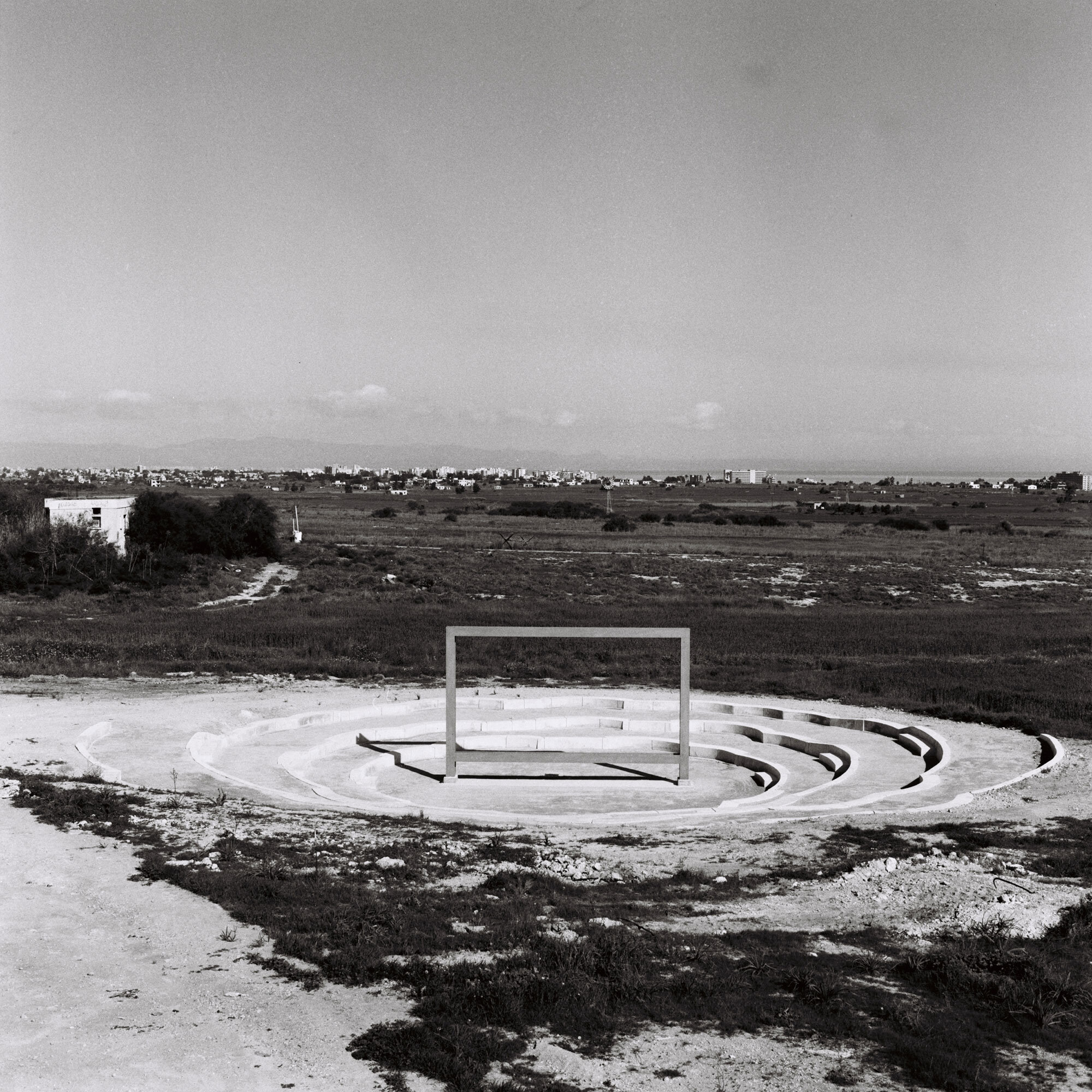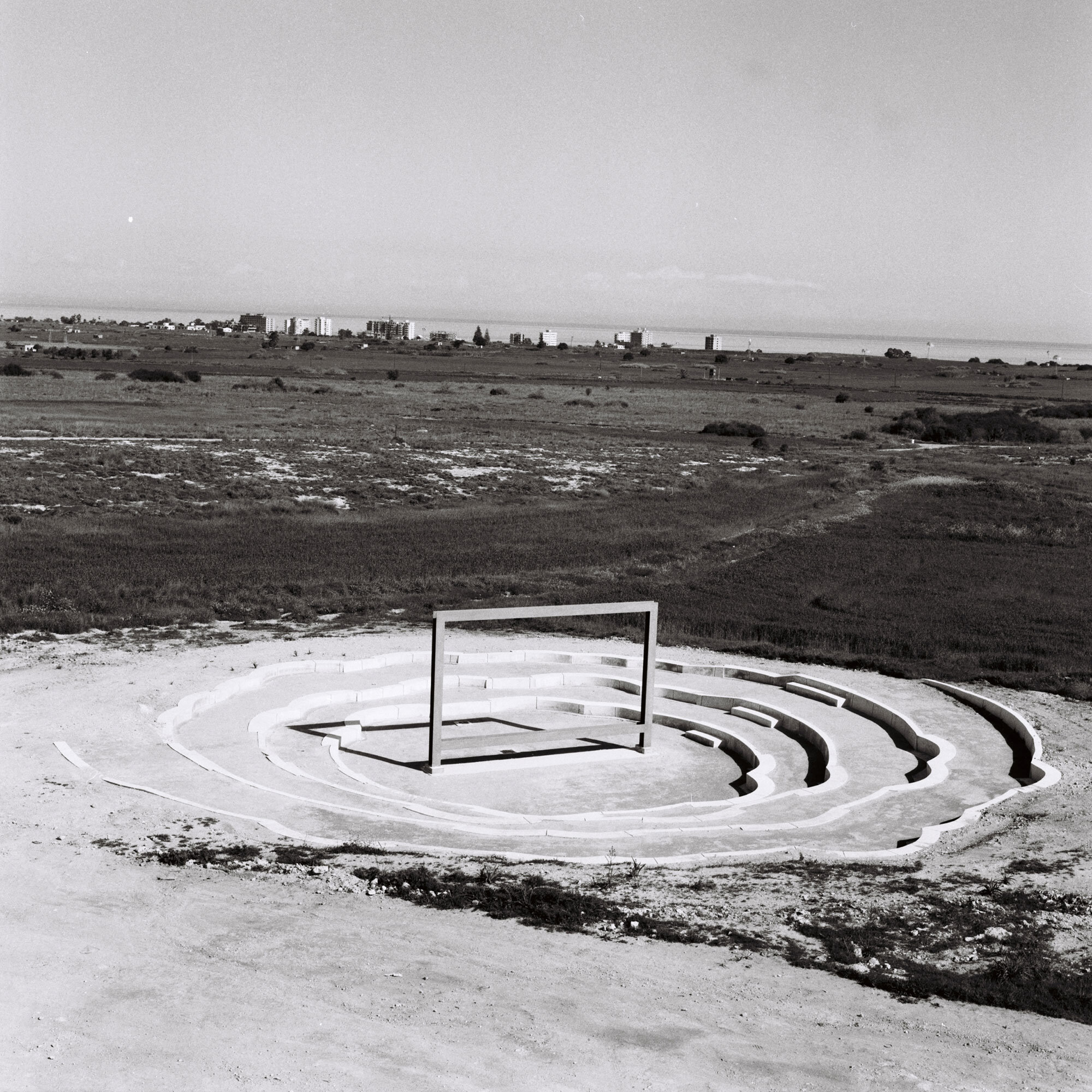Inside the Outset: Evoking a Space of Passage is a project by artist and filmmaker Rosa Barba following an invitation by Point Centre for Contemporary Art in Nicosia and curator Mirjam Varadinis to propose and realize a project in Cyprus.
The work proposed by the artist in 2013, started in 2014 and consists of two parts: a film and a long-term open-air cinema installation. The project was then presented to the Italian Council and received the first prize at the international competition (Third Edition) in 2018, and was awarded a grant from DGAAP (Directorate General for Contemporary Art and Architecture and Urban Peripheries), Italy.
For the construction, the artist focused on incorporating the theatre in Deryneia’s natural environment, avoiding materials alien to the landscape. In exchange with local architects, and under the supervision by the architect Maya Shopova, Barba worked exclusively with earth materials on site. Only the screen supporting structure and the drainage system had to be imported to the overall construction. The metal structure of the screen is the only visible part above ground, while the seats are integrated in the natural terrain. This extraordinary architectural technique allows the theatre to endure within the environment for the next ten years without any further necessary restoration—deteriorating gradually, as a subject to the area’s weather conditions.
Barba envisions the location of this open-air installation to function as a meeting point for the members of all communities on the island. Her intention is to highlight the capacity of the art to create spaces of interaction and coexistence. The inaugural screening took place at Deryneia in September 2021. Upon completion of Barba’s project, the open-air site will subsequently be made available to Deryneia Municipality and to all film and video practitioners of the island and beyond to initiate a multifaceted dialogue or simply a meeting point.
Coming together at Inside the Outset: Evoking a Space of Passage (Rosa Barba, 2021)
On the eastern side of Cyprus, in the periphery of the village of Deryneia, within the 180-km-long, UN-controlled Buffer Zone that runs across the island dividing it between the Turkish-speaking North and the Greek-speaking South, there lies an unobtrusive earthwork sculpture. It consists of a small amphitheatre, seamlessly sculpted onto the terrain using rammed earth material from the actual site, and a pale green metal frame nestled in the middle – its colour symbolically blending it into its surroundings, as it recalls the other appellation by which the Buffer Zone is known, the ‘Green Line’, named after the green chinagraph pencil Major General Peter Young used in 1963, when Cyprus was still a British colony, to draw a line that split the capital city, Nicosia in two, before it was extended across the whole island in 1974. The work constitutes one component of a two-part project (the other being a film shot entirely in Cyprus), titled Inside the Outset: Evoking a Space of Passage (2021) by artist Rosa Barba.
Barba conceived of the installation as an open-air cinema, with the metal frame functioning as a screen on which films can be projected and simultaneously watched by viewers on either side of the line. As in her other artworks, cinema becomes here ‘an instrument to interrogate the qualities of space’, to use the artist’s own words in talking about her practice in On the Anarchic Organisation of Cinematic Spaces (2021). Only in Inside the Outset her interest does not lie in the cinematic apparatus itself and its sculptural properties. Rather, Barba turns her attention to the function and significance of cinema as an institution and as a social practice: a spatio-temporal structure, where not only audiences encounter (familiar and new) images and sounds, but also, and perhaps most importantly, where (imagined and real) communities meet one another. By focusing on the importance of cinema as a social and experiential space in this work, Barba re-constructs the Buffer Zone into a contact zone. Continuing her preoccupation with contested landscapes, bearing the traces of destructive human intervention, the artist offsets the site’s prevailing associations with division and conflict by re-imagining it as a site of exchange and cohabitation between the different communities of the island. From this perspective, the installation’s permeable screen functions as a window that opens us up to a new space, both spatially and mentally, inviting us to think in different directions and to adopt alternative perspectives, moving beyond traumatic past events and entrenched ideologies.
Barba’s decision to build a cinema that is not enclosed taps into a long tradition of open-air cinema-going in the Mediterranean region – one that is particularly cherished and highly romanticised in Cyprus, Turkey and Greece. This is echoed, for instance, in Greek troubadour, Loukianos Kilaidonis’s Summer Cinemas (1978), in which he sings wistfully about long-gone youthful summer nights spent amidst the fragrance of jasmine and honeysuckle in open-air cinemas (1978). It is also expressed by Nobel laureate Orhan Pamuk in The Museum of Innocence (2009), as he laments Istanbul’s gentrification and the ensuing disappearance of open-air cinemas and their gardens, which had always functioned as demotic and egalitarian spaces, where different classes and genders could come together. Similarly, in ‘Conflict, Community and the “National” Audience: Remembering Turkish Cypriot Cinemagoing in 1950s Nicosia’ (2020), Jonathan Stubbs and Barçın Boğaç observe that, during the last decade of colonial rule, going to both the so-called ‘winter’ and ‘summer palaces’ was the most popular leisure activity in Cyprus, which enabled some level of interaction amongst the island’s fragmented population and offered an escape from the reality of inter-communal violence, before it reached an irreversible point of escalation.
It is precisely within this inclusive dimension where the crux of Barba’s open-air cinema in the Buffer Zone lies, that is, in the potential it holds for the creation of a new social space; one in which different ways of seeing and being can be mobilised, as well as new alliances can be formed and shared memories can be created. In the way Inside the Outset invites us to reconsider our understanding and experience of the Buffer Zone as no longer a site of conflict but of comings-together, the artwork calls to mind the Foucauldian concept of heterotopia. For Michel Foucault, heterotopia is a place that relates with all other places in a manner that calls into question, nullifies, or reconstructs the array of relationships and realities that it is meant to represent. As such, it serves as a site of subversion and transformation, enabling multiple layers of meaning to emerge and to intersect in unexpected ways.
This is particularly important in such an over-inscribed space as the Buffer Zone. Typical conceptualisations and visualisations of the Buffer Zone revolve around destruction: ruins, desertion, an untended natural environment overrun by overgrown foliage — all conveying a sense of abandonment and decay wrought by war and stalled time. In fact, the whole of the island has been marked by hard lines. Military scars, such as the omnipresent barbed wire, underground boltholes and elevated watchtowers, checkpoints, restricted zones and access signs, are imprinted across the land, warning you where your boundaries begin and end, while acting as constant reminders of the ongoing division. When not etched by the impact of militarisation, the landscape is weighed down by the burden of nationalism. From the 426-metres-wide flag of the Northern Republic of Cyprus carved on the side of Beşparmaklar Mountain/Mount Pentadaktylos facing south to the large-scale bronze or marble sculptures on either side of the Buffer Zone commemorating war heroes and political figures, such as Mustafa Kemal Atatürk (founding father of the Republic of Turkey) and Archbishop Makarios III (the first president and ethnarch of the Republic of Cyprus), the island’s terrain is strewn with monumental nationalist symbols. Unlike these static, cumbersome sculptures that invade and occupy the land, Barba’s land art intervention is gentle, discreet, fluid. There is an openness and generosity in this work that does not seek to demarcate a strictly defined place for itself neither in space nor in time. Inconspicuous in scale, you might actually miss it if you don’t go actively looking for it. Made from material found in its actual location, as mentioned before, Inside the Outset co-exists quietly with its natural landscape, all the while pressing the question upon us: how do we want to co-exist?
This question, however, is yet to be addressed. Since its inauguration in September 2021, during which Barba’s film (the second part of Inside the Outset), along with films selected by the project’s Advisory Board of artists from across the island were screened, the open-air cinema has lain dormant. This lingering has lent the work an uncanny feeling of strangeness; a sense of ghostliness that is further enhanced by the cinema’s close proximity to the so-called ‘Ghost City’ of Varosha. A once buzzing seaside resort area in the city of Famagusta (formerly known as the ‘Riviera of the Eastern Mediterranean’), Varosha has been occupied by the Turkish armed forces since 1974, becoming – until its recent controversial opening – a forbidden zone left to crumble and collapse. Remaining unused and undecided in this haunted space, with its transparent screen evoking a space of passage that is awaiting to be traversed and explored, the open-air cinema is strongly reminiscent of Jacques Derrida’s figure of the ghost. Neither fully of the present nor of the past, Barba’s installation, like Derrida’s spectre, calls on us to confront all those unwelcome spectres that haunt the way we view not only our history but also our possible futures.
Inside the Outset was seven years in the making. From the start, Barba developed the open-air cinema as a long-term project with the intention of being made available to Cyprus’s art and film communities and with the ensuing aim that this would open up opportunities for cultural activity and civic interaction among the diverse ethnic populations of the island and beyond. At a time when both the South and the North are gearing up to commemorate the 50th anniversary of what is viewed as an ‘invasion’ in the Greek-speaking South and as an ‘intervention’ in the Turkish-speaking North, it would be a loss if we didn’t reactivate the Buffer Zone’s open-air cinema to try to find ways to see through and to learn to live with our ghosts.
Olga Kourelou
Nicosia, March 2024
--
Olga Kourelou is an independent film scholar and curator, with a PhD in Film Studies from King’s College London. Having held teaching positions at King’s College London and Sussex University, she is now Research Fellow at the University of Nicosia, while also serving as an Honorary Member of the Cyprus Cinema Advisory Committee.
Inside the Outset: Evoking a Space of Passage, 2021
Open-Air Cinema Sculpture
Produced by Point Centre for Contemporary Art, funded by the Italian Council. A collaboration with Famagusta Avenue Garage.
Photos: Marios Stylianou © Rosa Barba

